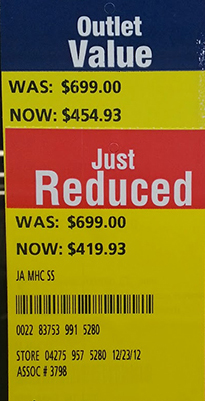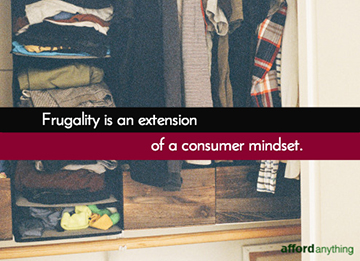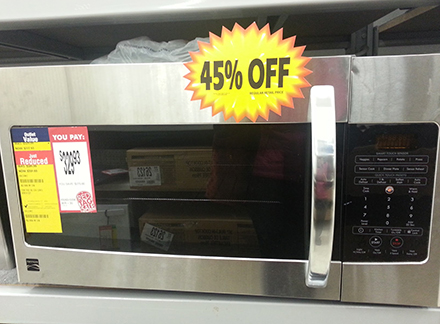
During the holidays, millions of Americans swarm upon stores across the nation.
Stores respond by dropping prices.
Why? Why does a surge in demand trigger lower prices?
If demand spikes and supply stays (mostly) the same, prices should rise instead of fall. Right?
Humor me for a moment:
Imagine that you own a retail store. You get about 50 customers each week. But you know 100 shoppers will descend upon your store next week, clamoring to buy your goods.
“Sweet!,” you think.
But wait … It gets better.
These aren’t leisurely shoppers. These shoppers have a tight “deadline” – December 25 – by when they must make the purchase. They’re time-crunched, they’re stressed, and damn it, it’s cold outside.
These 100 buyers are ready, willing and able to whip out their wallets and finalize the deal. Now.
Furthermore, you know that this batch of 100 customers won’t stick around as regulars. By January, you’ll be back to your regular 50 customers per week again.
As a store owner, what would you do?
Wouldn’t you be tempted to raise prices? Just a little bit?
I would.
Except that doesn’t happen. Instead, retailers respond to a surge in demand by dropping prices.
So I’ll ask again: Why?
What can this teach us about our own buying behavior? And most importantly, how can it keep us from getting suckered by sales gimmicks?
Read on.
How Store Discounts Trick You
Stores don’t (just) drop prices to compete with other stores. That’s part of the reason. But that’s not the whole story.
Stores drop prices to create more demand.
Retailers understand a critical truth about human behavior: When people think they’re getting a great deal, they’ll make impulse purchases.
Sure, you may need to buy presents during the holidays. That’s fine.
But discounts and sales are trying to lure you into spending more than you otherwise would.
Which means that if you want to save money, holiday sales may be your nemesis rather than your friend.
According to retail analysts, buyers have three types of responses to a store discount:
Neutral –
These customers would buy at any price point, regardless of whether the item is full-price or discounted. Brand loyalty trumps price.
Negative –
These customers react to cheap prices with skepticism. Their minds assign a higher “perceived value” to expensive products.
Have you ever heard someone say, “This $80 bottle of wine” as a shorthand method of communicating, “This good bottle of wine?” That’s the psychological phenomenon of conflating price with quality.
The adage “you get what you pay for” reflects consumer bias towards believing that higher-priced items must necessarily offer better quality. In these customer’s minds, if you discount the price of an item, you also discount its value.
But there’s a third category of consumers …
Positive –
These customers are impulsive. They love the “thrill of a deal,” and discounts and coupons trigger them to purchase items they otherwise wouldn’t buy.
Discounts, coupons, and clearance deals are like crack to an impulsive shopper. They enjoy the irresistible “high” of scoring a great deal.
That “high” leads to spending more money, not less.
By the way, I’m not using the crack analogy lightly. When we’re presented with a sale, discount or deal, our brains are flooded with the same chemicals that may assist in forming addictions. Read on …
Happy Chemicals
Why do we love sales so much?
Our brains are hardwired to feel “happiness” – in the form of a chemical called dopamine – when we encounter novelty (shopping for new items) and when we think we’ve scored a big win (finding a great deal).
As this CBS News report says:
“During a shopping experience, the human brain … releases the chemical dopamine … which has a role in our ability to experience pleasure or pain. It appears also to have a role in addictive behavior.”
This rush intensifies when people are presented with a “sale,” which causes our brain to light up as though it’s received a reward.
“Dopamine is … always triggered when we see a sale sign,” Mark Ellwood, author of the book Bargain Fever, told KARE 11 News in Minneapolis. (Ellwood refers to dopamine as “buy-agra,” which I think is hilarious.)
Sales, discounts, coupons and deals use the principals of human psychology to coerce consumers to spend more, not less.
“Look, I scored this Xbox 360 for 40 percent off!” – Says dopamine-fueled brain.
“Were you planning on buying one?” – Says rational brain.
“Well, no …” – (Rational brain, you’re such a buzzkill!)
Stores aren’t discounting items out of the generosity of their hearts. They’re dropping prices to boost sales. Plain and simple.
But Does The Math Work Out?
Let’s crunch a few numbers.
Imagine that you own a store. You only sell one item, which is priced at $100. Your overhead and expenses equal $70 per item.
During the holidays, you have two options:
Option A: You can sell at full-price to 100 people. Your overhead stays the same.
Option B: You can sell at a 20 percent discount to 500 people. However, your overhead rises to accommodate that additional sales volume. You need to employ extra staff, keep the lights on longer, and handle more customer service inquiries. This increases your overhead by 5 percent, which is an additional $3.50 per item.
If You Choose Option A: (Sell for $100 to 100 people with overhead of $70 per item)
$10,000 revenue
$7,000 expense
$3,000 profit
If You Choose Option B: (Sell for $80 to 500 people with the added overhead of $73.50 per item)
$40,000 revenue
$36,750 expense
$3,250 profit
You’ve boosted your profits by 8.3 percent by offering shoppers a discount.
****
But here’s the catch:
If you run these numbers with anything less than 5x the sales volume, the retailer loses money by offering the discount. If only 4x as many people shop, for example, the retailer loses money on the deal.
 Once the sales volume climbs to 5x or higher, the retailer makes mouthwatering profits.
Once the sales volume climbs to 5x or higher, the retailer makes mouthwatering profits.
So here’s the (literally) million-dollar question: Can a retailer get 5 times as many customers to swipe their credit cards by tempting them with a holiday discount?
In a word: Yes. (At least, the successful retailers can.)
More than half of the adult U.S. population shopped on Black Friday this year. More than half.
There are 240 million American adults, according to the U.S. Census Bureau, 141 million of whom whipped out their wallets for Black Friday deals.
That’s 58 percent of the U.S. adult population.
That’s astounding.
Holiday season sales account for up to 40 percent of U.S. retailers’ annual revenue, according to this New York Times report.
This phenomenon doesn’t just happen in the U.S.
In 2012, several department stores in Brazil more than doubled their annual revenue by rolling out “deals and discounts” coinciding with Black Friday (despite the fact that there’s no Thanksgiving holiday in Brazil).
The bottom line: Discounts motivate people to flock to the stores and spend more money.
No wonder retailers enjoy heavily discounting their items every Christmas. (And every President’s Day, Memorial Day, Labor Day, and every other holiday when people congregate at malls or on shopping websites.)
How to Save 100 Percent – This Week Only!
I shock a lot of people when I tell them that Afford Anything is a money-blog that doesn’t promote clipping coupons or scoring hot deals.
I don’t believe in encouraging rampant deal-chasing.
Sure, I’ll use Groupon as much as the next person. But 9 times out of 10, I’m using it impulsively to buy junk I don’t need.
“Whoa, 50 percent off a cucumber-coffee grounds facial?! Score!”

Frugality is an extension of a consumer mindset. If you’re thinking about scoring hot deals, your mental focus is on buying stuff – not on boosting your net worth and benefitting the world.
Sure, you’re finding discounts and deals. But you’re still a spender. You’ll save 30 percent by purchasing the item on sale, but you’ll save 100 percent by avoiding the purchase in the first place. Think like a creator, not a consumer.
The key to saving money isn’t chasing deals or discounts. It’s curbing your impulsive spending.
Staying out of stores (and away from online shopping) is the single most effective way to curb that impulse.
So avoid the sales and beware of steep holiday discounts — especially if you’re trying to build your savings or pay down debt. Those sales might be more dangerous to your bank account than you realize.
